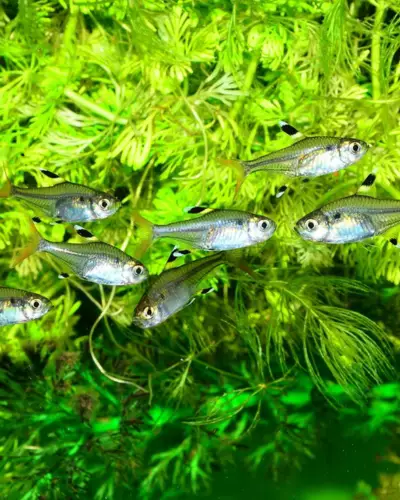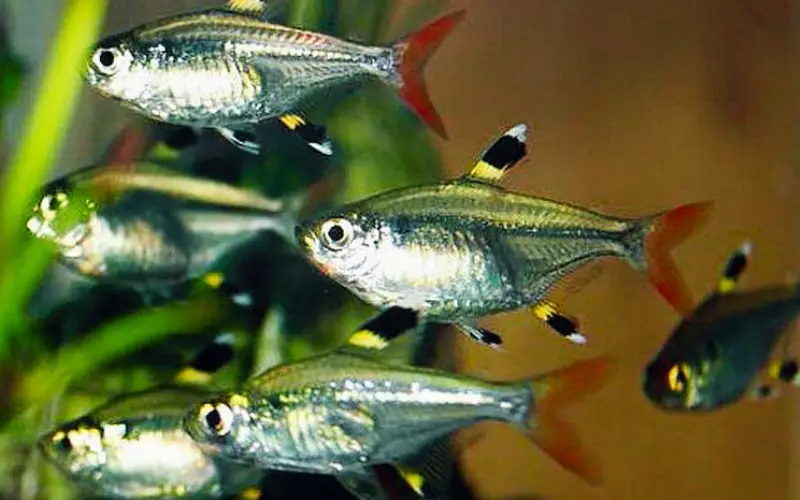The X-Ray Tetra, also known as the Pristella Tetra, is a small and captivating freshwater fish that has become popular among aquarium enthusiasts. Its unique translucent body and vibrant red fins make it a visually noticeable addition to any aquarium. This article will delve into the fascinating world of X-Ray Tetra facts and information.
Originating from the Amazon River basin in South America, X-Ray Tetras are peaceful and social creatures that thrive in shoals.
Their small size and quiet nature make them an ideal community fish, compatible with various tank mates.
Despite their delicate appearance, pristella maxillaris fish are hardy and relatively easy to care for, making them an excellent choice for beginner aquarists.

From their diet and behavior to their breeding habits and natural habitat, there is much to learn about these captivating little fish. Join us as we explore the intriguing world of Tetras and uncover some exciting X-ray fish facts along the way.
Table of Contents
Toggle9 Interesting X-Ray Tetra Facts in Aquariums
One of the most fascinating species of fish in the home aquarium is the x-ray tetra. Also known as the golden pristella tetra, this schooling fish is commonly known for its translucent skin, which makes it appear as though you can see through its internal organs.

These tropical freshwater fish are non-aggressive and can be kept in groups in a breeding tank, where the female x-ray tetra will spawn among the vegetation. Interestingly, the X-ray tetra’s diet consists of small crustaceans like worms and other crustaceans in acidic water typically found in their natural habitat.
In their natural habitat, the x-ray tetra is found in brackish waters where they live in large groups of at least six individuals. They also form symbiotic relationships with other fish, such as the goldfinch tetra, which helps them avoid larger predatory fish.
In an aquarium setting, it is essential to keep the water parameters stable to ensure the health of these delicate tetra species.
Facts #1: X-Ray Pristella maxillaris Tetra is native to the Amazon Basin.
These pristella tetras thrive in slightly acidic water with dense vegetation, mimicking their natural habitat in the Amazon tributaries. They get their name from how their skin appears to shimmer when light hits it, resembling x-ray images. To breed, they need a separate tank with a weberian apparatus to lay up to 400 eggs.
Facts #2: X-ray Tetra are small in size.
X-ray tetra, commonly known as the x-ray or x-ray tetra, are small aquarium fish in the Amazon. They are a species of characin known for their transparent skin, allowing you to see their bony internal structure.
These small fish only grow to around 2 inches in maximum size and are non-aggressive, making them a great addition to a community tank. The X-ray Tetra gets its name from the skin that covers their bodies, allowing them to provide a unique glimpse into their physiology.
Facts #3: X-ray Tetra are known for their transparent body Skin.
X-ray Tetra are known for their transparent bodies, allowing a glimpse into their internal organs and skeleton. These fish with transparent bodies are non-aggressive and thrive in schools of at least six. Found in the Amazon and Orinoco basins and South American coastal waters, they are bony fish that live or freeze and feed on planktonic animals.
Facts #4: X-Ray Tetra are peaceful and social fish.
Whether you’re a beginner or an experienced fishkeeper, X-Ray Tetras are a fantastic choice. Their peaceful nature and social tendencies make them easy to care for and a joy to watch. So, if you want to add tranquility and social dynamics to your aquarium, consider the remarkable X-Ray Tetra. These fish will undoubtedly enhance the beauty and liveliness of your underwater world.
Facts #5: X-Ray Tetra are omnivorous feeders.
Pristella maxillaris Tetra are omnivorous feeders, which means they eat plants and other small animals. They can be kept with other non-aggressive fish like Pristella tetra and goldfinch, but providing a separate breeding tank is essential as they may eat their eggs.
Facts #6: X-Ray Tetra is pretty easy to care of.
X-Ray Compared to other fish species, Tetras are relatively easy to care for. They are known as the Golden Pristella Tetra and the Water Goldfinch and thrive in groups of at least 6. Small-bodied fish prefer clean water with minimal pollution and can be fed pellets or small insects.
The dorsal and goldenfinch skin is considered transparent as they are named after the sound waves that pass through their bodies. Unfortunately, they are listed on the IUCN Red List due to decreased water quality, especially in streams and tributaries.
Facts #7: X-ray Tetra are known for their black and yellow fin displays.
X-Ray Tetra are known for their fin displays, which shimmer and reflect light in an eye-catching manner. The fish’s small body makes these displays even more dramatic as they move gracefully through the water.
These displays are essential in murky conditions or when there is pollution in the water, as they help the pristella tetra stand out. Overall, the goldfinch displays of the tetra add a touch of beauty and elegance to any aquarium.
Facts #8: X-Ray Tetra is easy to breed in captivity.
X-Ray Tetra are known for being easy to breed in captivity. With the right conditions and care, they can reproduce quickly. Breeders can raise healthy offspring by providing a suitable environment, such as clean water and a proper diet. This makes them popular for hobbyists looking to start a breeding project.
Facts #9: X-Ray Fish is compatible with other peaceful fish species.
X-ray Tetra is compatible with other peaceful fish species, such as pristella and goldfinch tetra. They thrive in a community tank environment as long as they are provided with the proper water quality and space conditions. Mixing X-Ray Tetra with other peaceful fish can create a beautiful and harmonious aquarium setup.
More Fun Facts about X-ray Fish for Kids
They are peaceful and social fish that do well in a school of six or more. They are often kept in community tanks with other small fish like the goldfinch tetra. When well-cared for in clean water, X-ray fish can live up to five years in captivity.
Here are more fun facts about X-ray fish for kids:
- Super See-Through! X-ray fish, known as Pristella tetras, have fragile, translucent skin. This lets you see their silvery insides, including their backbone, just like an X-ray picture!
- Hear with their Backbone! X-ray fish have a unique structure in their body called the Weberian apparatus. This lets them pick up sound waves through their bones, giving them super hearing!
- Tiny Titans! These little fish are only about 2 inches long but come in a school! They like to swim together in large groups for protection.
- Flashing Fins! X-ray fish have a splash of color on their fins. They can be black, white, or yellow black and white, making them shimmer as they dart through the water.
- Friend Finder! X-ray fish are peaceful and get along well with other calm fish in the aquarium.
- Baby Boom! Female X-ray fish can lay hundreds of eggs at a time! The babies, called fry, are tiny and transparent, just like their parents.
- Superpower of Stealth? Some people think their see-through skin helps them hide from predators in the rivers of South America.
Commonly Asked Questions about X-ray Tetra Fish Facts (FAQs)
What is a fact about X-ray tetras?
X-ray tetras are named for their translucent bodies, which make their skeletons visible! These peaceful fish are famous aquarium residents for their unique look and easy care.
How long do X-ray tetras live?
On average, X-Ray Tetras live 3-5 years, but with reasonable care in a clean tank, they can thrive for up to 7-8 years!
Are X-ray tetras peaceful?
Yes, X-Ray Tetras are peaceful schooling fish. They thrive with other small tetras, rasboras, and calm bottom dwellers. Avoid housing them with aggressive or fin-nipping tankmates.
Are X-ray tetras easy to breed?
Breeding X-ray tetras themselves is considered relatively easy. The challenge lies in raising the delicate fry, requiring infusoria and specific water conditions.
Do tetras have a swim bladder?
Yes, tetras have a swim bladder! This gas-filled organ helps them control their buoyancy and stay effortlessly in the water column.
Conclusion
In conclusion, the mesmerizing X ray tetra is truly a wonder of the aquatic world. This tiny fish captivates hobbyists and scientists, from its transparent body to its vibrant red coloration. We have explored the fascinating facts about this unique species, including its schooling behavior, adaptability to various environments, and exceptional ability to communicate through light signals. The X-ray tetra’s popularity as an aquarium fish is well-deserved, as it brings a touch of magic and beauty to any tank.
By learning more about the X ray tetra, we gain a deeper understanding of the natural world and appreciate the intricate wonders beneath the water’s surface. Whether you are a seasoned aquarist or fascinated by the mysteries of marine life, the X-ray tetra offers a captivating subject to explore and admire.
So, next time you find yourself gazing into an aquarium, take a moment to appreciate the enchanting X-ray tetra and its remarkable qualities. Dive into the world of x-ray tetra facts, and let these extraordinary creatures spark your curiosity and love for the wonders of our planet’s diverse ecosystems.
Recommended posts
- Pristella Tetra Size: 3 Factors That Influence Their Growth!
- Where Do X-Ray Fish Live in the World (Habitat Diversity)
- X Ray Tetra Lifespan 101: Secret Tips to Prolong their Life!
- What Do X-Ray Tetra Eat: (Best Pristella Maxillaris Diet)
- X Ray Tetras Fish 101: A Guide to Pristella Maxillaris Care
- Pristella Tetra Male Vs Female (How to Identify the Gender!)
- Are X Ray Tetra Fish Real: Pristella Maxillaris (Facts & Myths)
- How to Replicate the Natural X-Ray Tetra Fish Habitat in Aquarium




